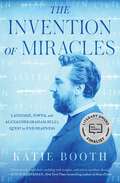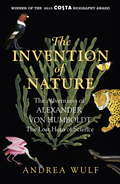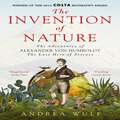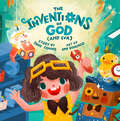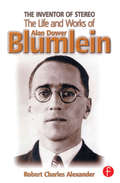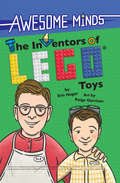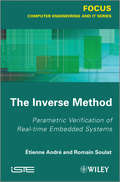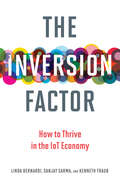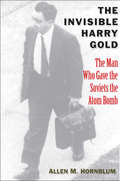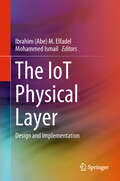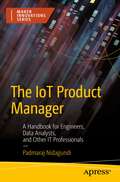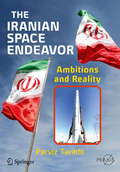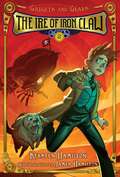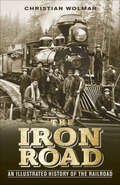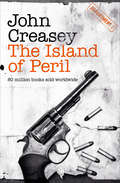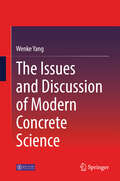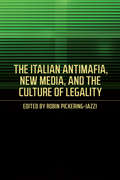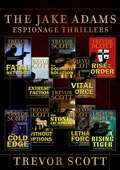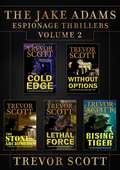- Table View
- List View
The Invention of Miracles: Language, Power, and Alexander Graham Bell's Quest to End Deafness
by Katie BoothFinalist for the PEN/Jacqueline Bograd Weld Award for Biography Finalist for the Mark Lynton History Prize &“Meticulously researched, crackling with insights, and rich in novelistic detail&” (Steve Silberman), this &“provocative, sensitive, beautifully written biography&” (Sylvia Nasar) tells the true—and troubling—story of Alexander Graham Bell&’s quest to end deafness. &“Researched and written through the Deaf perspective, this marvelously engaging history will have us rethinking the invention of the telephone.&” —Jaipreet Virdi, PhD, author of Hearing Happiness: Deafness Cures in History We think of Alexander Graham Bell as the inventor of the telephone, but that&’s not how he saw his own career. As the son of a deaf woman and, later, husband to another, his goal in life from adolescence was to teach deaf students to speak. Even his tinkering sprang from his teaching work; the telephone had its origins as a speech reading machine. The Invention of Miracles takes a &“stirring&” (The New York Times Book Review), &“provocative&” (The Boston Globe), &“scrupulously researched&” (Pittsburgh Post-Gazette) new look at an American icon, revealing the astonishing true genesis of the telephone and its connection to another, far more disturbing legacy of Bell&’s: his efforts to suppress American Sign Language. Weaving together a dazzling tale of innovation with a moving love story, the book offers a heartbreaking account of how a champion can become an adversary and an enthralling depiction of the deaf community&’s fight to reclaim a once-forbidden language. Katie Booth has been researching this story for more than fifteen years, poring over Bell&’s papers, Library of Congress archives, and the records of deaf schools around America. But she&’s also lived with this story for her entire life. Witnessing the damaging impact of Bell&’s legacy on her family would set her on a path that overturned everything she thought she knew about language, power, deafness, and the telephone.
The Invention of Nature: The Adventures of Alexander von Humboldt, the Lost Hero of Science: Costa & Royal Society Prize Winner
by Andrea WulfWINNER OF THE 2015 COSTA BIOGRAPHY AWARDWINNER OF THE ROYAL SOCIETY SCIENCE BOOK PRIZE 2016'A thrilling adventure story' Bill Bryson'Dazzling' Literary Review 'Brilliant' Sunday Express'Extraordinary and gripping' New Scientist'A superb biography' The Economist'An exhilarating armchair voyage' GILES MILTON, Mail on Sunday Alexander von Humboldt (1769-1859) is the great lost scientist - more things are named after him than anyone else. There are towns, rivers, mountain ranges, the ocean current that runs along the South American coast, there's a penguin, a giant squid - even the Mare Humboldtianum on the moon. His colourful adventures read like something out of a Boy's Own story: Humboldt explored deep into the rainforest, climbed the world's highest volcanoes and inspired princes and presidents, scientists and poets alike. Napoleon was jealous of him; Simon Bolívar's revolution was fuelled by his ideas; Darwin set sail on the Beagle because of Humboldt; and Jules Verne's Captain Nemo owned all his many books. He simply was, as one contemporary put it, 'the greatest man since the Deluge'.Taking us on a fantastic voyage in his footsteps - racing across anthrax-infected Russia or mapping tropical rivers alive with crocodiles - Andrea Wulf shows why his life and ideas remain so important today. Humboldt predicted human-induced climate change as early as 1800, and The Invention of Nature traces his ideas as they go on to revolutionize and shape science, conservation, nature writing, politics, art and the theory of evolution. He wanted to know and understand everything and his way of thinking was so far ahead of his time that it's only coming into its own now. Alexander von Humboldt really did invent the way we see nature.
The Invention of Nature: The Adventures of Alexander von Humboldt, the Lost Hero of Science: Costa & Royal Society Prize Winner
by Andrea WulfWINNER OF THE 2015 COSTA BIOGRAPHY AWARDWINNER OF THE ROYAL SOCIETY PRIZE 2016'Dazzling' Literary Review 'Brilliant' Sunday Express'Extraordinary and gripping' New Scientist'A superb biography' The Economist'An exhilarating armchair voyage' GILES MILTON, Mail on Sunday Alexander von Humboldt (1769-1859) is the great lost scientist - more things are named after him than anyone else. There are towns, rivers, mountain ranges, the ocean current that runs along the South American coast, there's a penguin, a giant squid - even the Mare Humboldtianum on the moon. His colourful adventures read like something out of a Boy's Own story: Humboldt explored deep into the rainforest, climbed the world's highest volcanoes and inspired princes and presidents, scientists and poets alike. Napoleon was jealous of him; Simon Bolívar's revolution was fuelled by his ideas; Darwin set sail on the Beagle because of Humboldt; and Jules Verne's Captain Nemo owned all his many books. He simply was, as one contemporary put it, 'the greatest man since the Deluge'.Taking us on a fantastic voyage in his footsteps - racing across anthrax-infected Russia or mapping tropical rivers alive with crocodiles - Andrea Wulf shows why his life and ideas remain so important today. Humboldt predicted human-induced climate change as early as 1800, and The Invention of Nature traces his ideas as they go on to revolutionize and shape science, conservation, nature writing, politics, art and the theory of evolution. He wanted to know and understand everything and his way of thinking was so far ahead of his time that it's only coming into its own now. Alexander von Humboldt really did invent the way we see nature.Recorded by arrangement with Doubleday, an imprint of the Knopf Doubleday Publishing Group, a division of Penguin Random House LLC; (P)2015 Highbridge, a division of Recorded Books
The Invention with a Thousand Uses (Fountas & Pinnell LLI Red #Level J)
by Christine KielAn Invention Named for a Duck? It was used in war. It's sticky. And it was named for a duck. What is it?
The Inventions of God (Made in His Image)
by Dave ConnisThis delightfully illustrated picture book tells the story of inventor extraordinaire Eva—and the God who created her to be a lot like Him.Little Eva is a budding engineer who loves to invent machines, toys, and robots that bring her joy. But where does her curiosity, creativity, and pizzazz come from? Meet God. He loves to invent, too, and delights in His creations, especially Eva. God and Eva are A LOT alike because God made Eva to be just like Him.Eva loves her inventions, but maybe not their earlier versions. God loves Eva, every version of her, and He wants her to know just how much. Parents and children alike will relish the playful illustrations and the gentle reminder that the image of God is alive in each of us.
The Inventions, Researches, and Writings of Nikola Tesla: With Special Reference To His Work In Polyphase Currents And High Potential Lighting (classic Reprint) (Wordsworth Classics)
by Thomas Commerford MartinThe early works of famed inventor Nikola Tesla, and a source of inspiration for generations of innovators. At the time it was first published in 1893, The Inventions, Researches, and Writings of Nikola Tesla was considered the bible of electrical engineering and inspired generations of inventors. This volume, edited by Tesla’s contemporary, Thomas Commerford Martin, includes extensive discussion of Tesla’s early work and inventions and contains more than 300 illustrations that demonstrate the practical application of his ideas. Tesla, who was born in what is now Croatia, is best known for his research into the use of high-frequency alternating currents and wireless transmission. Many of his ideas have found practical application in the modern world, and he continues to be a source of inspiration and fascination to this day.
The Inventor of Stereo: The life and works of Alan Dower Blumlein
by Robert AlexanderThis book is the definitive study of the life and works of one of Britain's most important inventors who, due to a cruel set of circumstances, has all but been overlooked by history. Alan Dower Blumlein led an extraordinary life in which his inventive output rate easily surpassed that of Edison, but whose early death during the darkest days of World War Two led to a shroud of secrecy which has covered his life and achievements ever since.His 1931 Patent for a Binaural Recording system was so revolutionary that most of his contemporaries regarded it at as more than 20 years ahead of its time. Even years after his death, the full magnitude of its detail had not been fully utilized. Among his 128 Patents are the principle electronic circuits critical to the development of the world's first electronic television system. During his short working life, Blumlein produced patent after patent breaking entirely new ground in electronic and audio engineering.During the Second World War, Alan Blumlein was deeply engaged in the very secret work of radar development and contributed enormously to the system eventually to become 'H2S'- blind bombing radar. Tragically, during an experimental H2S flight in June 1942, the Halifax bomber in which Blumlein and several colleagues were flying, crashed and all aboard were killed. He was just days short of his 39th birthday.For many years there have been rumours about a biography of Alan Blumlein, yet none has been forthcoming. This is the world's first study of a man whose achievements should rank among those of the greatest Britain has produced. This book provides detailed knowledge of every one of his patents and the process behind them, while giving an in depth study of the life and times of this quite extraordinary man.
The Inventor's Secret: What Thomas Edison Told Henry Ford
by Suzanne SladeBoth Thomas Edison and Henry Ford started off as insatiably curious tinkerers. That curiosity led them to become inventors—with very different results. As Edison invented hit after commercial hit, gaining fame and fortune, Henry struggled to make a single invention (an affordable car) work. Witnessing Thomas's glorious career from afar, a frustrated Henry wondered about the secret to his success. This little-known story is a fresh, kid-friendly way to show how Thomas Edison and Henry Ford grew up to be the most famous inventors in the world—and best friends, too.
The Inventors of LEGO® Toys (Awesome Minds)
by Erin Hagar Paige GarrisonEveryone has played with LEGO® toys, but not many people know who is behind this awesome invention. This fun and engaging book tells the story of how a Danish carpenter and his family turned a desperate situation into the most popular toy in history. <P><P>With full-color illustrations and lively text, and chock-full of interesting facts, Awesome Minds: The Inventors of LEGO® Toys is the perfect read for those with creative spirits and curious minds. <P><P>This book is an independently authored and published biography of the family that created the LEGO® construction toy and is not sponsored or endorsed by or affiliated in any way with the LEGO Group of companies, owner of the LEGO® trademarks. <br>Lexile Level: 970L <br>Guided Reading Level: R4
The Inverse Method: Parametric Verification of Real-time Unbedded Systems (Focus Ser. #4)
by Romain Soulat Etienne AndréThis book introduces state-of-the-art verification techniques for real-time embedded systems, based on the inverse method for parametric timed automata. It reviews popular formalisms for the specification and verification of timed concurrent systems and, in particular, timed automata as well as several extensions such as timed automata equipped with stopwatches, linear hybrid automata and affine hybrid automata. The inverse method is introduced, and its benefits for guaranteeing robustness in real-time systems are shown. Then, it is shown how an iteration of the inverse method can solve the good parameters problem for parametric timed automata by computing a behavioral cartography of the system. Different extensions are proposed particularly for hybrid systems and applications to scheduling problems using timed automata with stopwatches. Various examples, both from the literature and industry, illustrate the techniques throughout the book. Various parametric verifications are performed, in particular of abstractions of a memory circuit sold by the chipset manufacturer ST-Microelectronics, as well as of the prospective flight control system of the next generation of spacecraft designed by ASTRIUM Space Transportation. Contents: 1. Parametric Timed Automata. 2. The Inverse Method for Parametric Timed Automata. 3. The Inverse Method in Practice: Application to Case Studies. 4. Behavioral Cartography of Timed Automata. 5. Parameter Synthesis for Hybrid Automata. 6. Application to the Robustness Analysis of Scheduling Problems. 7. Conclusion and Perspectives. About the Authors Étienne André is Associate Professor in the Laboratoire d’Informatique de Paris Nord, in the University of Paris 13 (Sorbonne Paris Cité) in France. His current research interests focus on the verification of real-time systems. Romain Soulat is currently completing his PhD at the LSV laboratory at ENS-Cachan in France, focusing on the modeling and verification of hybrid temporal systems.
The Inversion Factor: How to Thrive in the IoT Economy (The\mit Press Ser.)
by Linda Bernardi Sanjay E. Sarma Kenneth TraubWhy companies need to move away from a “product first” orientation to pursuing innovation based on customer need.In the past, companies found success with a product-first orientation; they made a thing that did a thing. The Inversion Factor explains why the companies of today and tomorrow will have to abandon the product-first orientation. Rather than asking “How do the products we make meet customer needs?” companies should ask “How can technology help us reimagine and fill a need?” Zipcar, for example, instead of developing another vehicle for moving people from point A to point B, reimagined how people interacted with vehicles. Zipcar inverted the traditional car company mission. The authors explain how the introduction of “smart” objects connected by the Internet of Things signals fundamental changes for business. The IoT, where real and digital coexist, is powering new ways to meet human needs. Companies that know this include giants like Amazon, Airbnb, Uber, Google, Tesla, and Apple, as well as less famous companies like Tile, Visenti, and Augury. The Inversion Factor offers a roadmap for businesses that want to follow in their footsteps.The authors chart the evolution of three IoTs—the Internet of Things (devices connected to the Internet), the Intelligence of Things (devices that host software applications), and the Innovation of Things (devices that become experiences). Finally, they offer a blueprint for businesses making the transition to inversion and interviews with leaders of major companies and game-changing startups.
The Invisible Harry Gold
by Allen M. HornblumIn the history of Soviet espionage in America, few people figure more crucially than Harry Gold. A Russian Jewish immigrant who spied for the Soviets from 1935 until 1950, Gold was an accomplished industrial and military espionage agent. He was assigned to be physicist Klaus Fuchs's "handler" and ultimately conveyed sheaves of stolen information about the Manhattan Project from Los Alamos to Russian agents. He is literally the man who gave the USSR the plans for the atom bomb. The subject of the most intensive public manhunt in the history of the FBI, Gold was arrested in May 1950. His confession revealed scores of contacts, and his testimony in the trial of the Rosenbergs proved pivotal. Yet among his co-workers, fellow prisoners at Lewisburg Penitentiary, and even those in the FBI, Gold earned respect, admiration, and affection. InThe Invisible Harry Gold, journalist and historian Allen Hornblum paints a surprising portrait of this notorious yet unknown figure. Through interviews with many individuals who knew Gold and years of research into primary documents, Hornblum has produced a gripping account of how a fundamentally decent and well-intentioned man helped commit the greatest scientific theft of the twentieth century.
The IoT Physical Layer: Design And Implementation (Analog Circuits And Signal Processing Series)
by Mohammed Ismail Ibrahim Abe ElfadelThis book documents some of the most recent advances on the physical layer of the Internet of Things (IoT), including sensors, circuits, and systems. The application area selected for illustrating these advances is that of autonomous, wearable systems for real-time medical diagnosis. The book is unique in that it adopts a holistic view of such systems and includes not only the sensor and processing subsystems, but also the power, communication, and security subsystems. Particular attention is paid to the integration of these IoT subsystems as well as the prototyping platforms needed for achieving such integration. Other unique features include the discussion of energy-harvesting subsystems to achieve full energy autonomy and the consideration of hardware security as a requirement for the integrity of the IoT physical layer. One unifying thread of the various designs considered in this book is that they have all been fabricated and tested in an advanced, low-power CMOS process, namely GLOBALFOUNDRIES 65nm CMOS LPe.
The IoT Product Manager: A Handbook for Engineers, Data Analysts, and Other IT Professionals
by Padmaraj NidagundiEnhance your product management skills and set yourself apart from other product managers working in the IoT industry. This book shows you how to navigate through the world of small and Edge devices to successfully launch and monitor products connected together to make smart environments.Working in Agile environments, you'll learn to guide UI builds that serve customer needs and function the way top tech companies expect. Then measure the right product metrics and create reporting dashboards for your IoT products. That way you can effectively engage partners, engineers, and stakeholders. And you’ll learn the entire end-to-end development process of IoT products so that you can make sure you make the right moves at the right stages. After mastering the IoT product lifecycle and measuring your success against KPIs, you’ll see how to work with marketing to effectively launch your product in the marketplace. Finally, a self-interview section has been provided so that you can evaluate your skills and responses to common IoT Product Manager questions. Then take what you've learned and go out into the world to develop integrated IoT products that your customers love!What You'll LearnCreate UI/UX experiences that engage and wow your customersWork in Agile environments with best business practicesNegotiate effectively at each step of the product lifecycleWho This Book Is ForAny wanting to build a IoT products. Aspiring Internet of Things product managers, product owners, analysts, business consultants, engineers, and business owners.
The Iranian Space Endeavor
by Parviz TarikhiProvides a detailed look at the events and policies surrounding the Iranian space endeavor. For those who see the trend of progress and movement of the Iranian space endeavor from the outside, it can be difficult to understand what goes on behind the scenes. However, for one who observes these events firsthand, they take on a very different meaning. In this book, the author brings new and different profiles of Iran's space endeavor to light. Iran claims to be the ninth leading country in the world capable of manufacturing satellites and launching them, plans to land an astronaut on the Moon within a decade, and says its own president plans to be the first Iranian astronaut to travel into space. The author explains in this book that not all of these claims are quite as they seem. In addition to technical explanations, the book also includes historical, legal, social and cultural aspects of Iran's space program as well. It is the author's goal to create a tangible feeling of Iran's space endeavor for the readers.
The Ire of Iron Claw
by James Hamilton Kersten HamiltonSomeone is smuggling secrets out of the Kennewicketts' lab and sabotaging their experiments, putting everyone at the Amazing Automated Inn at risk. In pursuit of the villains, the family of scientific geniuses board their dirigible and take to the skies. Together with their robotic staff and the inventor Nikola Tesla, they must face murderous sky pirates, cross the Alps in a giant mechanical spider, and defy the perilous pigeon Iron Claw and the malevolent magician Madini once more. Will boy inventor Wally and his daring dog, Noodles, be able to defeat the evil Mesmers and their minions a second time? History and technology collide in this fast-paced series narrated by a daring dachshund and brimming with mad science.
The Iron Road: An Illustrated History of the Railroad (DK Short Histories)
by Christian WolmarWritten by Christian Wolmar, author of the critically acclaimed The Great Railroad Revolution, The Iron Road is a richly illustrated account of the rise of the rails across the world. From the historic moment in September 1830 when the first train ran between Liverpool and Manchester, to the high speed trains bulleting across Asia and Europe, The Iron Road: An Illustrated History of the Railroad looks at how railroads have changed the world. Photographs, maps, paintings, and illustrations bring events and locations to life, adding a unique visual quality to the stories of great invention, feats of mind-boggling engineering, groundbreaking changes in trade and commerce, and tales of adventurers, visionaries, and rogues. The Iron Road is the third title in DK's successful illustrated histories format, which combines text-rich narratives with beautiful visual design.
The Island of Peril (Department Z #15)
by John CreaseyDepartment Z must stop the Nazis from deploying a deadly chemical weapon during World War II—from the author who sold eighty million books worldwide. On a top-secret island, the Germans are perfecting a paralyzing gas—one that could disable an entire infantry troop, a crew of a ship, or the pilots of aircraft. With the looming threat of this noxious gas, it’s up to Department Z to find this mysterious island where the gas is being manufactured and steal the formula to prevent the Germans from using it as their ultimate weapon. “Mr. Creasey realizes that it is the principal business of thrillers to thrill.” —Church Times “Little appears in the newspapers about the Secret Service, but that little makes anything on the subject probable fiction. Mr. Creasey proves himself worthy of the chance.” —The Times Literary Supplement
The Issues and Discussion of Modern Concrete Science
by Wenke YangThis book is devoted to two primary objectives. The first is to present the errors, inadaptability, and mistakes arising when the current theory on concrete is applied to explaining practical construction of concrete; the second is to put forward viewpoints in modern concrete science. Taking a number of engineering cases as examples, we experimentally studied and theoretically analyzed the errors, inadaptability, and mistakes when the current theory on concrete is applied to explaining practical construction of concrete. Moreover, we investigated the use of mixing ratios, aggregates, cement, high-performance concrete and fibers, as well as the frost resistance, cracking behavior, durability, dry shrinkage and autogenous healing to address and remedy the shortcomings in today's concrete science, put forward new proposals, and make a number of innovative achievements in the field, particularly in modern theory on concrete science. The results and topics which will be of particular interest to engineers and researchers include: corrections to several one-sided, even mistaken views on concrete construction in the field and a new theory that can be adopted to improve the durability of concrete projects, to control and improve the implementation quality of concrete projects, and to guide teaching in universities. Wenke Yang is a distinguished senior engineer at China Airport Construction Group Corporation, General Administration of Civil Aviation of China (CAAC).
The Issues and Discussion of Modern Concrete Science
by Wenke YangThis book is devoted to two primary objectives. The first is to present the errors, inadaptability, and mistakes arising when the current theory on concrete is applied to explaining practical construction of concrete; the second is to put forward viewpoints in modern concrete science.Taking a number of engineering cases as examples, we experimentally studied and theoretically analyzed the errors, inadaptability, and mistakes when the current theory on concrete is applied to explaining practical construction of concrete. Moreover, we investigated the use of mixing ratios, aggregates, cement, high-performance concrete and fibers, as well as the frost resistance, cracking behavior, durability, dry shrinkage and autogenous healing to address and remedy the shortcomings in today’s concrete science, put forward new proposals, and make a number of innovative achievements in the field, particularly in modern theory on concrete science. The results and topics which will be of particular interest to engineers and researchers include: corrections to several one-sided, even mistaken views on concrete construction in the field and a new theory that can be adopted to improve the durability of concrete projects, to control and improve the implementation quality of concrete projects, and to guide teaching in universities. Wenke Yang is a distinguished senior engineer at China Airport Construction Group Corporation, General Administration of Civil Aviation of China (CAAC).
The Italian Antimafia, New Media, and the Culture of Legality
by Robin Pickering-IazziThe past two decades have witnessed increasing opposition to mafia influence and activities in Italy. Community organizations such as Libera, founded in 1995, and Addiopizzo, originating in 2004, exemplify how Italian society has tried to come together to promote antimafia activities. The societal opposition to mafia influence continues to grow and the Internet has become a frontline in the battle between the two groups. The Italian Antimafia, New Media, and the Culture of Legality is the first book to examine the online battles between the mafia and its growing cohort of opponents. While the mafia’s supporters have used Internet technologies to expand its power, profits, and violence, antimafia citizens employ the same technologies to recreate Italian civil society. The contributors to this volume are experts in diverse fields and offer interdisciplinary studies of antimafia activism and legality in online journalism, Twitter, YouTube, digital storytelling, blogs, music, and photography. These examinations enable readers to understand the grassroots Italian cultural revolution, which makes individuals responsible for promoting justice, freedom, and dignity.
The JCT 05 Standard Building Contract
by Issaka Ndekugri Michael RycroftThe Joint Contracts Tribunal's (JCT) Standard Form of Building Contract, one of the most common standard contracts used in the UK to procure building work, is updated regularly to take account of changes in legislation and industry practice and relevant court decisions from litigation. The JCT 05 Standard Building Contract: Law and Administration is a second edition to the authors' earlier award-winning The JCT98 Building Contract: Law and Administration, and clarifies complex issues surrounding obligations and rights under the contract. This makes it an essential reference for construction professionals, employers, contractors, and lawyers new to construction seeking to update and consolidate their knowledge. The book also provides the knowledge and understanding of the contract, which are a fundamental part of the education of most students who go on to become managers and leaders in the construction industry. It thoroughly works through the provisions of the contract in simple language, using case law examples and relevant statute to demonstrate approaches to its interpretation.
The Jake Adams Espionage Thrillers: The First Ten Novels (A Jake Adams International Espionage Thr)
by Trevor ScottThe complete Jake Adams Espionage Thrillers series. Includes all 10 books: Fatal Network, Extreme Faction, The Dolomite Solution, Vital Force, Rise of the Order, The Cold Edge, Without Options, The Stone of Archimedes, Lethal Force, and Rising Tiger.
The Jake Adams Espionage Thrillers: Volume 2 (A Jake Adams International Espionage Thr)
by Trevor ScottA Simon & Schuster eBook. Simon & Schuster has a great book for every reader.
The Jake Adams International Espionage Thrillers: Volume 1 (A Jake Adams International Espionage Thr #1)
by Trevor ScottVolume 1 of the Best Selling Jake Adams International Espionage Thriller series containing books 1-5, Fatal Network, Extreme Faction, The Dolomite Solution, Vital Force, and Rise of the Order.
